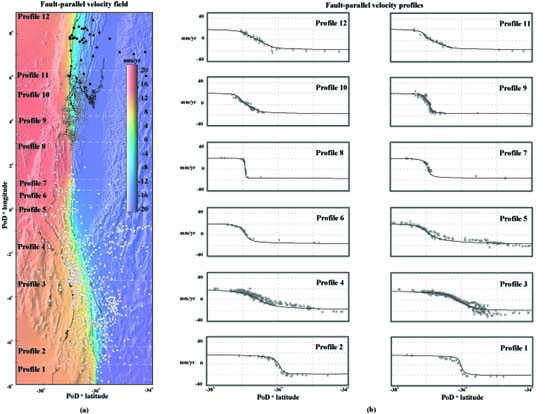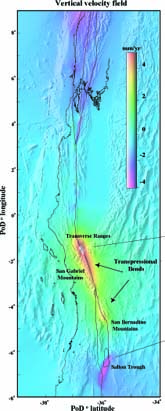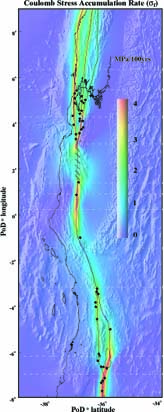Coulomb Stress Accumulation along the San Andreas Fault System
Bridget Smith and David Sandwell
J. Geophys. Res., 2003
Stress accumulation rates along the primary segments of the San Andreas Fault system are computed using a 3-D elastic half-space model with realistic fault geometry. The model is developed in the Fourier domain by solving for the response of an elastic half-space due to a point vector body force and analytically integrating the force from a locking depth to infinite depth. This approach is then applied to the San Andreas Fault system using published slip rates along 18 major fault strands of the fault zone.GPS-derived horizontal velocity measurements spanning then entire 1700 x 200 km region are then used to solve for apparent locking depth along each primary fault segment.
This simple model fits remarkably well (2.43 mm/yr rms misfit), although some discrepancies occur in the Eastern California Shear Zone.The model also predicts vertical uplift and subsidence rates that are in agreement with independent geologic and geodetic estimates. In addition, shear and normal stress along the major fault strands are used to compute Coulomb stress accumulation rate. As a result, we find earthquake recurrence intervals along the San Andreas Fault system to be inversely proportional to Coulomb stress accumulation rate, in agreement with typical co-seismic stress drops of 1-10 MPa.This 3-D deformation model can ultimately be extended to include both time-dependent forcing and viscoelastic response.



In addition, shear and normal stresses along the major fault streands are used to compute Coulomb stress accumulation rate. As a ersult, we find earthquake recurrence intervals along the San Andreas Fault system to be inversely proportional to Coulomb stress accumulation rate, in agreement with typical coseismic stress drops of 1-10 MPa. This 3-D deformation model can ultimately be extendend to include time-dependent forcing and viscoelastic response.
Home
Elastic model
Viscoelastic model